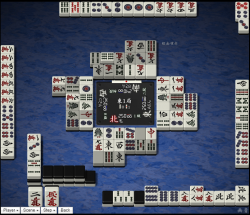Suukantsu: Difference between revisions
m (standardize intro) |
No edit summary |
||
| Line 27: | Line 27: | ||
[[Image:Hadakabind.png|thumb|250px|right|Suukantsu tenpai with an [http://tenhou.net/0/?log=2014031007gm-0009-7447-xfcc2dd624f0d&tw=3 inescapable hadaka tanki situation].]] | [[Image:Hadakabind.png|thumb|250px|right|Suukantsu tenpai with an [http://tenhou.net/0/?log=2014031007gm-0009-7447-xfcc2dd624f0d&tw=3 inescapable hadaka tanki situation].]] | ||
This yakuman requires four kan calls. As a result, the hand in [[tenpai]] always has a [[Tanki|hadaka tanki]] wait. In order to call | This yakuman requires four kan calls. As a result, the hand in [[tenpai]] always has a [[Tanki|hadaka tanki]] wait. In order to call each kan, a player must draw at least 3 out of 4 tiles of a single tile type: | ||
* A player has a pair and calls pon, then draws the fourth to [[shouminkan|call kan]]. | * A player has a pair and calls pon, then draws the fourth to [[shouminkan|call kan]]. | ||
* A player has a closed triplet and [[daiminkan|calls kan]] on a discarded fourth. | * A player has a closed triplet and [[daiminkan|calls kan]] on a discarded fourth. | ||
* A player draws all four of a tile type and [[ankan|calls kan]]. | * A player draws all four of a tile type and [[ankan|calls kan]]. | ||
Since suukantsu requires a player to draw into four closed triplets, any hand that scores suukantsu would also have met the requirements for the significantly easier [[suuankou]]. Since they are both worth the same value, there are very few reasons to go for suukantsu. | |||
*You must obtain a total of 4/4 tiles of four different types | |||
Reasons why suukantsu is so difficult: | |||
*If any other player has called kan, the hand becomes impossible. If playing with abortive draws, this will trigger [[suukaikan]]. If playing without, then players are still only allowed a combined total of 4 kans in one game. | *You must obtain a total of 4/4 tiles of four different types, where 3/4 are self drawn. | ||
*If any other player has called kan, the hand becomes impossible. If playing with abortive draws, this will trigger [[suukaikan]]. If playing without, then players are still only allowed a combined total of 4 kans in one game, preventing the yakuman. | |||
*Calling four kans adds a total of four kan dora, which will greatly boost the value of others' hands. A player may not want to kan even once in order to avoid the extra dora. | *Calling four kans adds a total of four kan dora, which will greatly boost the value of others' hands. A player may not want to kan even once in order to avoid the extra dora. | ||
*Open & added kans are the easiest type of kan, but they require you to open your hand. Since there is no [[yaku]] for a kan until the third kan, committing to an open kan is risky. | |||
*Calling four kans immediately reveals you have a yakuman hand, so players are likely to defend. | *Calling four kans immediately reveals you have a yakuman hand, so players are likely to defend. | ||
*The hand always has a hadaka tanki wait | *The hand always has a hadaka tanki wait. | ||
Finally, like any other yakuman, another player could have a faster hand and win before you. | Finally, like any other yakuman, another player could have a faster hand and win before you. | ||
Latest revision as of 13:01, 24 August 2024
| Type | Yakuman |
|---|---|
| Kanji | 四槓子 |
| English | Four kans |
| Value | Yakuman |
| Speed | Extremely slow |
| Difficulty | The most difficult |
Suukantsu 「四槓子」 is a yakuman scored when the hand has called kan four times. Suukantsu is the rarest hand in the game, even rarer than tenhou or chiihou. It is also the longest, requiring 18 tiles total.
Tile pattern
Development

This yakuman requires four kan calls. As a result, the hand in tenpai always has a hadaka tanki wait. In order to call each kan, a player must draw at least 3 out of 4 tiles of a single tile type:
- A player has a pair and calls pon, then draws the fourth to call kan.
- A player has a closed triplet and calls kan on a discarded fourth.
- A player draws all four of a tile type and calls kan.
Since suukantsu requires a player to draw into four closed triplets, any hand that scores suukantsu would also have met the requirements for the significantly easier suuankou. Since they are both worth the same value, there are very few reasons to go for suukantsu.
Reasons why suukantsu is so difficult:
- You must obtain a total of 4/4 tiles of four different types, where 3/4 are self drawn.
- If any other player has called kan, the hand becomes impossible. If playing with abortive draws, this will trigger suukaikan. If playing without, then players are still only allowed a combined total of 4 kans in one game, preventing the yakuman.
- Calling four kans adds a total of four kan dora, which will greatly boost the value of others' hands. A player may not want to kan even once in order to avoid the extra dora.
- Open & added kans are the easiest type of kan, but they require you to open your hand. Since there is no yaku for a kan until the third kan, committing to an open kan is risky.
- Calling four kans immediately reveals you have a yakuman hand, so players are likely to defend.
- The hand always has a hadaka tanki wait.
Finally, like any other yakuman, another player could have a faster hand and win before you.
Value
Despite the greater degree of difficulty and exceptionally low frequency of occurrence, the value remains as that of the other single yakuman.
External links
- Suukantsu in Japanese Wikipedia
| |||||||||||||||||||||||||||||||
